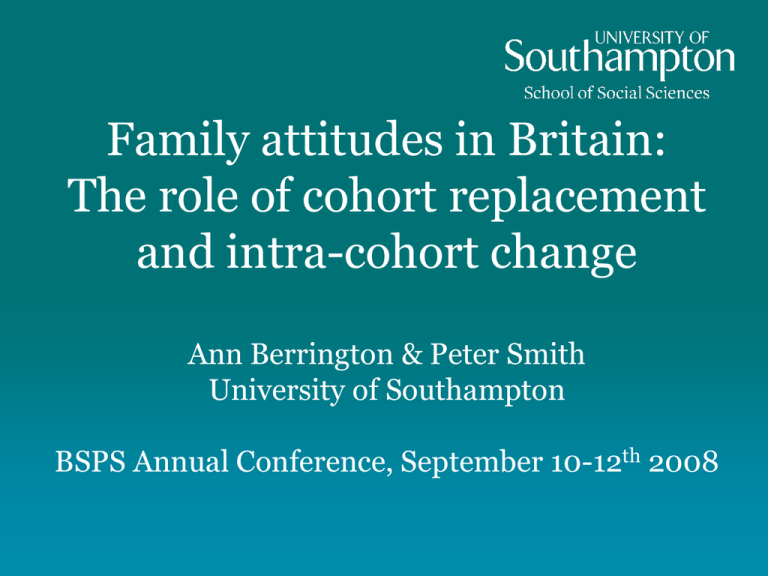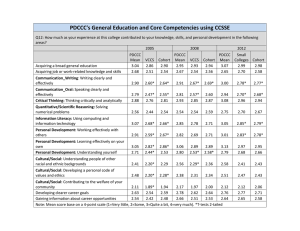
Family attitudes in Britain:
The role of cohort replacement
and intra-cohort change
Ann Berrington & Peter Smith
University of Southampton
BSPS Annual Conference, September 10-12th 2008
Background (1)
• Family Change
– Heterogeneity family forms historically
unprecedented Coontz (2004)
– Deinstitutionalisation of marriage Cherlin (2004)
– Individualization of personal life Giddens (1991),
Beck & Beck-Gernsheim (1995)
2
Background (2)
• Role of Ideational Change
– Lesthaeghe and van de Kaa (1987) Second demographic
transition – refer to Inglehart (1977) Post-materialism,
especially among cohorts born after World War II
– Sexual revolution – 1960s & 1970s separation of sex &
marriage
– Gay rights – legal recognition same sex partnerships
implemented in Civil Partnership Act, Dec 2005
3
How does attitudinal change
come about?
• Social norms change through
a) Cohort replacement (succession), and/or
b) Changes within individuals due to:
Ageing effects
Period effects
• Identification issue – within a single crosssectional survey age and cohort are perfectly
correlated
4
Research Questions
• To what extent have family attitudes changed over
time?
• What role do cohort replacement and intra-cohort
change in family attitudes play?
• What role do compositional changes e.g. education
and religiosity play?
5
Data
• British Social Attitude Survey 1984 onwards
• 18-83 years – annual sample 1000-3000 persons
• Repeated cross sectional data
• Attitude statements – sexual morality, childbearing
outside of marriage, cohabitation and divorce
– Question interpretation and consistency over 22
year period?
6
Sexual morality questions repeated within
the British Social Attitude Survey
• “If a man and a woman have
sexual relations before marriage,
what would your general opinion
be? Please choose a phrase from
this card”
• What about a married person
having sexual relations with
someone other than his or her
partner?.”
• “What about sexual relations
between two adults of the same
sex?”
1 = always wrong
2 = mostly wrong
3 = sometimes wrong
4 = rarely wrong
5 = not wrong at all
6 = depends/varies
Methods
• Descriptive analysis
• Quasi cohort approach – decomposing social
change
• Logistic regression of attitudes – attempting to
account for social change
8
Overall trend in sexual morality, Britain
1984-2006
100
90
80
70
60
50
40
30
20
10
0
62%
40%
42%
16%
1984 1986 1988 1990 1992 1994 1996 1998 2000 2002 2004 2006
Premarital sex "not wrong at all"
Homosexual sex "not wrong at all"
Source: BSA
Percentage who say that premarital sex "is not
wrong at all", by age at time of survey
100
90
80
70
60
50
40
30
20
10
18-28
Source: BSA
40-50
62-72
2006
2005
2004
2003
2002
20001
2000
1999
1998
1997
1996
1995
1994
1993
1992
1991
1990
1989
1988
1987
1986
1985
1984
0
Percentage who say that sex between adults of the
same sex "is always wrong", by age at time of survey
100
90
80
70
60
50
40
30
20
10
18-28
40-50
0
20 0
00
1
20
02
20
03
20
04
20
05
20
06
20
99
19
98
19
97
19
96
19
95
19
94
93
19
19
92
19
91
19
90
19
89
19
88
19
87
19
86
85
19
19
19
84
0
62-72
Decomposing Social Change
• We can decompose overall social change into that
which is between cohorts and within cohorts
(Firebaugh, 1989)
– Between cohort component of social trend can be
interpreted as cohort replacement “if one is willing to
assume that the age compositional differences between
the cohorts are not actually producing the effect” (Alwin
& McCammon, 2004, p. 4o)
– Within cohort component represents either ageing
and/or period effects
12
Quasi cohort approach
Year of
Birth
1978-88
1967-77
1956-66
1945-55
1934-44
1923-33
1912-22
1901-11
Age in 1984 Age in 1995 Age in 2006
18-28
29-39
40-50
51-61
62-72
73-83
18-28
29-39
40-50
51-61
62-72
73-83
-
18-28
29-39
40-50
51-61
62-72
73-83
-
• E.g. 11 year birth cohorts, followed over 22 year period
(1984-2006)
• Assumptions made
– Mortality risk not related to attitude of interest
– Population closed to migration
13
Percentage who say that premarital
sex is “not wrong at all”
Age
group
1984
1995
2006
66.9
78.5
72.8
59.8
38.8
30.3
Intercohort
change
84-95
4.9
9.1
15.5
15.5
4.6
1.0
Intracohort
change
84-95
Na
0.3
0
-4.9
2.3
-3.0
Intercohort
change
95-06
-5.8
10.4
13.8
21.2
18.4
12.5
Intracohort
change
95-06
Na
5.8
4.7
0.8
0.2
4.9
18-28
29-39
40-50
51-61
62-72
73-83
All age
groups
67.8
59.0
43.5
23.1
20.8
16.8
72.7
68.1
59.0
38.6
25.4
17.8
43.3
52.3
61.9
8.4
-0.9
11.8
3.3
Source: BSA 1984-2006
14
Percentage who say that premarital
sex is “not wrong at all”
Age
group
1984
1995
2006
66.9
78.5
72.8
59.8
38.8
30.3
Intercohort
change
84-95
4.9
9.1
15.5
15.5
4.6
1.0
Intracohort
change
84-95
Na
0.3
0
-4.9
2.3
-3.0
Intercohort
change
95-06
-5.8
10.4
13.8
21.2
18.4
12.5
Intracohort
change
95-06
Na
5.8
4.7
0.8
0.2
4.9
18-28
29-39
40-50
51-61
62-72
73-83
All age
groups
67.8
59.0
43.5
23.1
20.8
16.8
72.7
68.1
59.0
38.6
25.4
17.8
43.3
52.3
61.9
8.4
-0.9
11.8
3.3
Source: BSA 1984-2006
15
Percentage who say that sex between adults of
the same sex is “not wrong at all”
Age
group
18-28
29-39
40-50
51-61
62-72
73-83
All age
groups
1984
18.7
26.2
20.8
10.9
7.8
1.8
1995
34.0
32.6
26.5
15.4
6.6
4.0
2006
58.5
52.8
49.1
34.5
20.1
10.9
Intercohort
change
84-95
15.3
6.4
5.7
4.5
-1.2
2.2
16.4
22.1
39.7
5.5
Intracohort
change
84-95
13.9
0.3
-5.4
-4.3
-3.8
Intercohort
change
95-06
24.5
20.2
22.6
19.1
13.5
6.9
Intracohort
change
95-06
18.8
16.5
8.0
4.7
6.9
0.14
17.8
11.0
Source: BSA 1984-2006
16
Percentage who say that sex between adults of
the same sex is “not wrong at all”
Age
group
18-28
29-39
40-50
51-61
62-72
73-83
All age
groups
1984
18.7
26.2
20.8
10.9
7.8
1.8
1995
34.0
32.6
26.5
15.4
6.6
4.0
2006
58.5
52.8
49.1
34.5
20.1
10.9
Intercohort
change
84-95
15.3
6.4
5.7
4.5
-1.2
2.2
16.4
22.1
39.7
5.5
Intracohort
change
84-95
13.9
0.3
-5.4
-4.3
-3.8
Intercohort
change
95-06
24.5
20.2
22.6
19.1
13.5
6.9
Intracohort
change
95-06
18.8
16.5
8.0
4.7
6.9
0.14
17.8
11.0
Source: BSA 1984-2006
17
What role do changes in education
and religion play?
• Logistic regression proportion who say that premarital
sex and same sex “not wrong at all” in 2005/6
• Covariates
– Age
– Sex
– Marital status
– Economic activity status
– Highest educational qualification
– Religious attendance
See graphs
18
Educational
Qualification
Source: BSA
ne
ve
oc
r
ca
si
on
al
ly
an
nu
al
ly
m
on
th
ly
w
ee
kl
y
no
ne
cs
e
&
o
eq
ui
v
&
le
ve
l
de
gr
ee
2
1.8
1.6
1.4
1.2
1
0.8
0.6
0.4
0.2
0
a
Odds ratio
Predicted Odds Ratios for Premarital Sex
"Not wrong at all" outcome by Education and
Religious Attendance, 2005/6
Religious
Attendance
Predicted Odds Ratios for Homosexuality "Not wrong
at all" Outcome by Education and Religious
Attendance, 2005/6
1.4
1
0.8
0.6
0.4
0.2
Source: BSA
Educational
Qualification
Religious
Attendance
ee
kl
y
w
an
nu
al
ly
m
on
th
ly
lly
oc
ca
si
on
a
ne
ve
r
no
ne
cs
e
&
o
eq
ui
v
&
le
ve
l
de
gr
ee
0
a
Odds ratio
1.2
Logistic regression 1984-2006 data
(for cohorts fully observed)
Model 1
Model 2
Model 3
Survey year
Birth cohort
Survey year
Birth cohort
Sex
Marital Status
Economic Activity
Educational qualification
Survey year
Birth cohort
Sex
Marital Status
Economic Activity
Educational qualification
Religious attendance
21
Model 1
Source: BSA
Model 2
19
23
19 -3 3
34
19 -4 4
45
19 -5 5
56
-6
6
19
23
19 -3 3
34
19 -4 4
45
19 -5 5
56
-6
6
7
6
5
4
3
2
1
0
19
23
19 -3 3
34
19 -4 4
45
19 -5 5
56
-6
6
odds ratio
Predicted Odds Ratios For Acceptance of Premarital
Sex By Birth Cohort, 1984-2006
Model 3
Model 1
Source: BSA
Model 2
19
23
19 -3 3
34
19 -4 4
45
19 -5 5
56
-6
6
19
23
19 -3 3
34
19 -4 4
45
19 -5 5
56
-6
6
7
6
5
4
3
2
1
0
19
23
19 -3 3
34
19 -4 4
45
19 -5 5
56
-6
6
odds ratio
Predicted Odds Ratios For Acceptance of Homosexuality
By Birth Cohort, 1984-2006
Model 3
Conclusions I
• Attitudes towards premarital sex, same sex relationships &
childbearing outside of marriage continued to become more
liberal
• Rapid increase in approval of same sex relationships in
1990s and 2000s, following a move to more conservative
attitudes in late 1980s (HIV/AIDS publicity)
• Investigation of role of cohort, age and period effects on
attitude is problematic due to identification problem
• Results appear to be robust to assumptions made within
regression analysis
24
Conclusions II
• Social change in attitudes to premarital sex
– Largely driven by cohort replacement
– Increased acceptance premarital sex associated with
decline in religiosity
– Increase in education having an offsetting effect
25
Conclusions III
• Social change in attitudes to same sex relationships
– result of cohort replacement and intra-individual
change
– increased acceptance associated with increases in
education and declines in religiosity
– possible evidence for period effects late 1980s (more
conservative) and 2000-2006 (more liberal)
– period effects may not be linear - under 50s more
willing to adjust attitude in last decade
– In future likely to be continued liberalisation due to
cohort replacement – esp. until those now aged over 50
left the population
26
References
•
Alwin, D.F. and McCammon, R. J. (2004) Generations, cohorts and social change. Pp 2350 in J.T. Mortimer and M.J. Shanahan (eds.) Handbook of the Life Course. New York,
NY: Springer.
•
Crockett, A. and Voas, D. (2003) A divergence of views: Attitude change and the religious
crisis over homosexuality. Sociological Research Online, 8,4.
<http://www.socresonline.org.uk/8/4/crockett.html>
•
Duncan, S. and Phillips, M. (2008) New Families? Tradition and change in modern
relationships. Pp 1-28 in A. Park et al. (eds.) British Social Attitudes: The 24th Report.
London: Sage.
•
Mason, K. O., Mason, W. M., Winsborough, H. H. and Poole, K. W. (1973) Some
methodological issues in the cohort analysis of archival data. American Sociological
Review, 38,242-258.
•
Mason, K. O. And Lu, Y-H (1988) Attitude toward women’s familial roles: Changes in the
United States 1977-1985. Gender and Society, 2, 39-57. Cohort vs intra cohort. Regress
•
Rodgers, W. L. (1990) Interpreting the components of time trends. Sociological
Methodology, 20, 421-438.
•
Ryder, N. (1965) The cohort as a concept in the study of social change. American
Sociological Review, 30, 843-861
•
Scott, J. (1998) Changing attitudes to sexual morality: A cross-national comparison.
Sociology, 32, 815-845.
27


